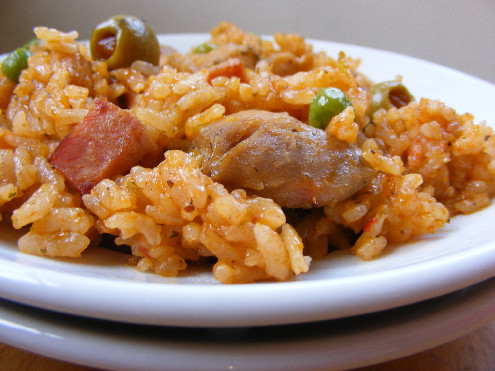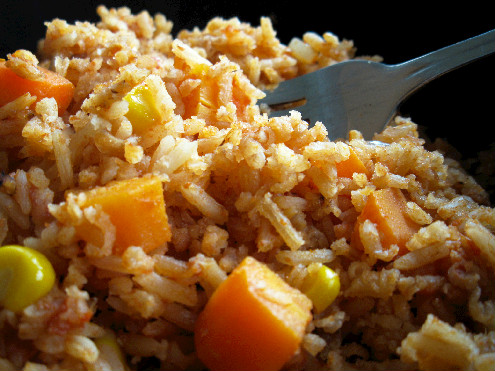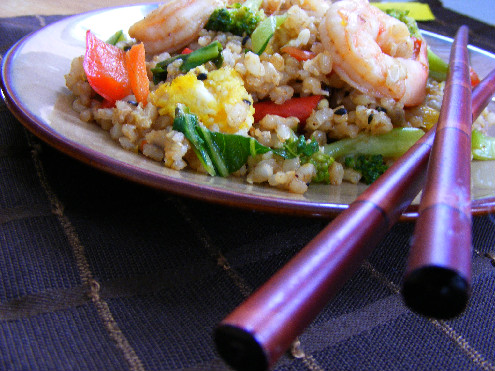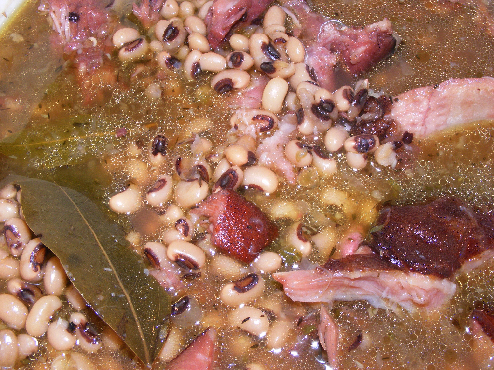Rice: Puerto Rican Rice with Chicken – Arroz con Pollo
Friday, April 16th, 2010A couple of months ago my amiga Kitty and I spent an afternoon cooking. She offered to show me how to make Puerto Rican arroz con pollo, rice with chicken.
I happily assumed the role of sous chef – peeling heads of garlic, chopping veggies, and stirring this and that. Meanwhile, Nivia was my window into the cultural and personal nuances of Puerto Rican cookery . . .
For starters, Puerto Rican cuisine employs a spectrum of cooking techniques and ingredients that reflect the island’s diverse inhabitants: the Caribbean native Tainos, Africans, Spanish, and other Europeans.
Three items are signature to the cuisine: adobo, sofrito and achiote. Arroz con pollo employs all three. No wonder it’s touted as the most popular chicken dish on the island.
Adobo: In Puerto Rican parlance, adobo is a seasoned salt. A wet adobo made of garlic, olive oil, salt, black pepper, oregano and citrus juice is rubbed on the chicken in this dish and marinated overnight. It’s the secret to moist and flavorful chicken, and it also infuses a layer of flavor to the rice. Sofrito: The rice is bursting with flavor because of the sofrito, a fresh bouillon of peppers, onions, garlic and herbs. (Read about sofrito and view recipe.) Achiote: Achiote is derived from annato seeds and is used for its subtle flavor and to give the dish a reddish hue. No saffron here, the less expensive achiote is a long-time tradition in Puerto Rican cooking. Achiote can be purchased as a paste, ground or in seed form. It is readily available in Latino markets and spice stores.
After cooking with Kitty, I did some research. The majority of recipes out there are more intuitive rather than specific. For a Puerto Rican arroz con pollo novice, that’s not helpful. I know, I made this dish three times in the last several weeks.
Here’s my final recipe, with a bit more detail – I’ve borrowed techniques I learned from Kitty, other Puerto Rican friends and research. Remember it’s the process that matters, so make certain to read the instructions thoroughly before you begin.
It serves six. You’ll be glad to have leftovers!
One more thing, don’t forget the little bits of crispy, cooked rice at the bottom of the pan are called “pegao.” It’s considered the best part of arroz con pollo by some aficionados.
Tidbits on Rice
- Rice was introduced to Puerto Rico by Columbus in his second trip to America in 1493 and has since become a primary food source.
- Long grain rice is said to be favored in Puerto Rico, according to some sources. However, medium and short grain rice are heavily favored in dishes like arroz con pollo and arroz con gandules.
- Arroz con pollo dates back to the eighth century to Andalusia, when the Moors occupied Spain. It has become a popular rice dish in nearly all of Latin America and the Caribbean, with regional variations, of course.
Sources: The Oxford Encyclopedia of Food and Drink in America; Puerto Rican Dishes by Berta Cabanillas and Carmen Ginorio.







 Eating black eyed peas on New Year’s Day is a longtime custom among African Americans and Southerners who believe the legumes will bring prosperity and good luck, especially when paired with greens, which symbolize money. Some folks say you just need to eat a spoonful and others say at least 365 (one for each day of the year). Regardless, this year, in this economy, the superstitious dare not skip this tradition.
Eating black eyed peas on New Year’s Day is a longtime custom among African Americans and Southerners who believe the legumes will bring prosperity and good luck, especially when paired with greens, which symbolize money. Some folks say you just need to eat a spoonful and others say at least 365 (one for each day of the year). Regardless, this year, in this economy, the superstitious dare not skip this tradition.



